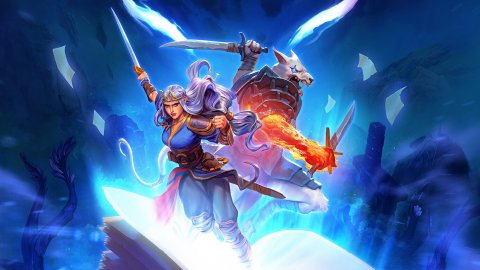Roguebook, the tried

A unique and recognizable style from Belgium
Roguebook is the second title in Abrakam's roster, with a first project always based on collectible cards, that Faeria rather positively received by the public and supported by long in recent years. With Roguebook, however, things get even more interesting as the credits include a certain Richard Garfield, creator of that Magic The Gathering still today the undisputed lord of trading card games. It is interesting to see that in this passage of the baton the graphic style, the vivid and bright colors and the atmosphere have remained almost intact, maintaining a common thread between the two productions with a demonstration of continuity that is not always so obvious for this kind of productions. At the beginning of the adventure you will be catapulted into a storybook and instead of having consequential battles in quick succession, the title will give you full control of your hero, free to move at will on a map with hexagons.Roguebook: a battle The pages of the book begin to color, with pastel colors that light up the hexagons indicating the way forward, on each box you can then meet special treasures, gold coins, characters to interact with and also other heroes to enlist in your party. In the demo we had only the warrior Sharra and the toad defender Sorocco but other fighters were clearly visible such as the seifer rat, most likely associated with an assassin and the enchanting turtle Aurora.
Arrived on a combat box you will abandon the isometric view to end up in a turn-based battle in the most classic 2D where you will have to use your attack and defense cards to defeat the various enemies, in pure Slay the Spire style . Each card will have its cost and each turn will completely recharge your hand, allowing you to anticipate the opponent's moves in order not to succumb and obtain the coveted rewards. The very interesting and addictive thing to add to the equation is the ability to change positions of your heroes by playing some specific cards, thus allowing you to activate passive buffs to make the task easier, or maybe avoid a champion receiving a lethal blow prematurely. >
Exploration becomes an integral part
Roguebook: the deck creation phase While roguelikes based on card battles usually relegate exploration to the marginal part, or exclude it altogether, Roguebook places it on a pedestal while also adding a pinch of strategy. Many of the hexagons on the map, in fact, will initially be desaturated and in order to make them walkable again, discovering what they hide inside them, you will have to use special ink bottles. Of these there are various shapes and sizes, some will color in a straight line, others in a circle around you and you can usually receive them as a reward for defeating enemies.Exploring the new areas you will be able to get in touch with artifacts and precious gems, other essential elements to facilitate your climb towards the boss at the end of the level. If the artifacts work exactly as you would expect from this type of games, i.e. offering passive abilities during fights, the gems forcefully enter the art of deck building by adding unique modifiers to the cards, thus allowing you to duplicate the options in your hand, reduce costs or even summon allies on the battlefield. The only thing that at the moment did not convince us a lot of what we saw, however underlining the limitation of our first test, concerns the attack mechanics of the enemies and bosses, already seen identical in many other games of the genre by limiting the experience to a sort of deja vù that we hope will vanish as soon as it is possible to progress further in the story.
Needless to say, in case roguelikes with a deck building soul are your bread, this is a title to follow carefully. The few hours of testing showed interesting ideas and a game structure that is certainly able to leave you with the desire to continue challenging yourself and inventing increasingly effective strategies and decks. The doubt remains as to how innovative these mechanics can truly be compared to what is seen in similar titles such as Monster Train and Slay the Spire but this is an evaluation that we will leave for our review, currently scheduled for the end of June, in conjunction with the release of the title on Steam.